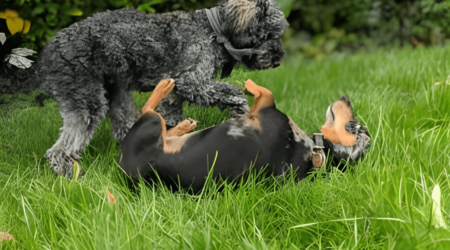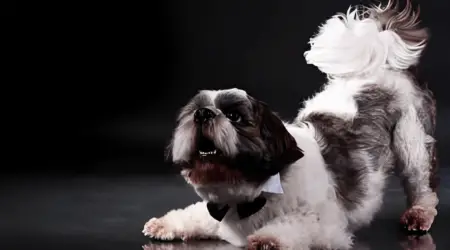How To Train A Staffy Not To Jump? Helps& Guide
Meet your energetic and lovable Staffordshire Bull Terrier Staffy, always ready for a playful leap. While their enthusiasm is infectious, teaching them not to jump can make your bond even stronger. In this guide, we’ll explore simple and effective ways to address this common behavior.
From understanding why they jump to incorporating positive reinforcement techniques, we’ll break it down step by step. Get ready to foster good manners and create a harmonious connection with your Staffy because a well-behaved pup is a happy pup!
Understanding the Jumping Behavior
Jumping is a natural instinct for our lively Staffordshire Bull Terriers Staffies. To train them effectively, it’s crucial to understand why they leap in the first place.
Greeting and Excitement:
- Staffies may jump when they’re happy to see us.
- Excitement and eagerness to interact can trigger jumping.
Attention-Seeking:
- Jumping is a way for Staffies to grab our attention.
- It’s a common behavior when they want to engage with us.

The Fundamentals of Positive Reinforcement Training
- Reward-Based System: Positive reinforcement involves rewarding your Staffy with treats, praise, or play when they exhibit the desired behavior. This strengthens the connection between the action and the positive outcome.
- Timing is Everything: Immediate reinforcement is key. Reward your Staffy as soon as they display the desired behavior to ensure they associate the action with the reward.
- Consistency Matters: Be consistent in rewarding positive behavior and withholding rewards for undesirable actions. This clarity helps your Staffy understand what is expected.
- No Punishments: Avoid punishment-based methods. Positive reinforcement focuses on building a positive bond and trust between you and your Staffy rather than instilling fear.
Preparation for Training
Supplies and Tools:
- Treats: Use small, tasty treats to reward good behavior.
- Leash and collar/harness: Essential for control during training sessions.
- Clicker (optional): A clicker can be a helpful tool for marking desired behavior.
Timing and Location:
- Choose the right time: Pick moments when your Staffy is calm and receptive for training.
- Optimal location: Start in a quiet and familiar space to minimize distractions.
Create a Positive Environment:
- Positive vibes: Ensure a positive and calm atmosphere during training.
- Minimize distractions: Turn off TVs or reduce background noise to help your Staffy focus.
Basic Commands to Introduce
“Sit” Command:
- Step-by-Step:
a. Hold a treat close to your Staffy’s nose, moving your hand upwards.
b. As their head follows the treat, their bottom will naturally lower.
c. Once in a sitting position, say “sit” and give them the treat. - Consistency:
a. Repeat daily in short sessions.
b. Use the command in various situations to reinforce the behavior.
“Stay” Command:
- Gradual Introduction:
a. Begin with your Staffy in a sitting position.
b. Open your palm and say “stay” while taking a step back.
c. Reward them if they remain seated. - Building Patience:
a. Increase the duration gradually.
b. Practice “stay” in different environments to generalize the command.
Addressing Jumping Behavior Specifically
1. Ignoring the Jump:
- When your Staffy jumps, turn your back calmly and avoid eye contact.
- Fold your arms and say nothing until all four paws are on the ground.
- Once they settle, turn around and reward them with praise and attention.
- This teaches them that jumping leads to no attention, while calm behavior gets rewarded.
2. Redirecting with Commands:
- As soon as your Staffy approaches, ask them to “Sit” or “Down” before they have a chance to jump.
- Reward them promptly for following the command.
- Practice this consistently whenever they greet you or guests.
- This establishes a new routine for polite greetings.
3. Managing Greetings:
- Keep your Staffy on a leash when greeting guests to control their initial excitement.
- Ask guests to crouch down to greet your Staffy at their level, reducing the temptation to jump.
- Instruct guests to ignore any jumping and only interact when your Staffy has all four paws on the ground.
- This ensures consistency in rewarding calm behavior, even with visitors.
4. Providing Alternatives:
- Ensure your Staffy gets plenty of exercise and playtime to release energy.
- Offer interactive toys or chews to redirect their attention when guests arrive.
- Teach them to “Fetch” or engage in other activities that channel their energy positively.
- This helps them learn appropriate ways to express excitement and engage with people.
Consistency is Key
Clear Expectations:
- Consistent training sets clear expectations for your Staffy.
- They learn to associate specific behaviors with predictable outcomes.
Reinforces Learning:
- Regular practice reinforces the desired behaviors.
- Repetition helps your Staffy understand and retain the training commands.
Builds Trust and Confidence:
- Consistency builds trust between you and your Staffy.
- Predictable responses create a sense of security, boosting their confidence in the training process.
Avoids Confusion:
- Inconsistent training can confuse your Staffy.
- They might struggle to understand what is expected, hindering the learning process.
Small Steps Lead to Big Progress:
- Consistency in small, daily efforts leads to significant long-term progress.
- Celebrate small victories, reinforcing positive behavior consistently.
Troubleshooting Common Challenges
Dealing with Stubborn Behavior:
- Stay patient and calm frustration can hinder progress.
- Break down training into smaller steps, rewarding incremental improvements.
Adjusting for Individual Personalities:
- Tailor your approach to your Staffy’s unique personality.
- Some may respond better to treats, while others may prefer play as a reward.
- Observe your Staffy’s reactions to understand what motivates them.
Seeking Professional Help:
- If challenges persist, consider consulting a professional dog trainer.
- They can provide insights into your Staffy’s behavior and offer specialized guidance.
- Attend group classes for socialization and additional support.
FAQs
Why does my Staffy jump so much?
- A: Staffies, being naturally enthusiastic and social, may jump for joy, attention, or as a way of greeting. Understanding these instincts helps tailor your training approach to address these specific needs.
How long will it take to see results?
- A: Each Staffy is unique, so results may vary. Consistent practice and positive reinforcement contribute to quicker progress. Celebrate small victories along the way, and remember that patience is key.
What if my Staffy is stubborn during training?
- A: Patience is crucial. Break down training into smaller steps, adjust techniques to suit your Staffy’s personality, and consider seeking advice from a professional trainer for personalized guidance.
Can I use punishment to stop jumping?
- A: Positive reinforcement is recommended over punishment. Focusing on rewarding desired behaviors builds trust and a positive bond, ensuring a more effective and humane training process.
Also Read: Why Are Staffies So Affectionate? Helps & Guide
Summary
Teaching your Staffy not to jump is a rewarding endeavor that strengthens your bond and enhances their manners. By understanding their behavior, embracing positive reinforcement, and staying consistent, you pave the way for a well-behaved and joyful companion. Celebrate the small victories, remain patient during challenges, and remember that training is an ongoing process.
The effort you invest today will shape a courteous and well-adjusted Staffy, creating a harmonious coexistence and ensuring a lifetime of joyful companionship. Embrace the journey, savor the progress, and revel in the delightful transformation of your Staffy into a well-mannered family member.












Leave a Reply